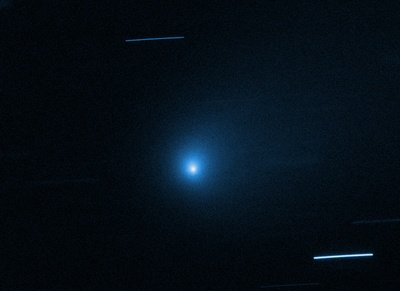Hubble probes Alien Comet's Chemical makeup
Interstellar comet 2I/Borisov is providing a glimpse of another star system's planetary building blocks, using new observations from NASA's Hubble Space Telescope.
Borisov is the first known comet to originate from a different star system than our own. Measurements find that it has an unusual abundance of carbon monoxide largely unlike comets belonging to our solar system. Researchers say its unusual composition points to a likely birthplace of a carbon-rich circumstellar disk around a cool red dwarf class of star. These observations are a prime opportunity to sample the chemistry of the material in a primordial disk around another star.
Comets are condensed samples of gas, ice, and dust that form swirling in the disk around a star during the birth of its planets. Studying comets is important because astronomers are still trying to understand the role they play in the buildup of planets. They can also redistribute organic material among young planets, and may have brought water to the early Earth. These activities are likely happening in other planetary systems, as demonstrated by Borisov's makeup.
"With an interstellar comet passing through our own solar system, it's like we get a sample of a planet orbiting another star showing up in our own back yard," said John Noonan of the Lunar and Planetary Laboratory at the University of Arizona, Tucson, who is a member of the Hubble research team led by Dennis Bodewits of Auburn University in Alabama.
The team used Hubble's unique ultraviolet sensitivity to spectroscopically detect carbon monoxide gas escaping from comet Borisov's solid comet nucleus. Hubble’s Cosmic Origins Spectrograph observed the comet on four separate occasions, from Dec. 11, 2019 to Jan. 13, 2020, which allowed the researchers to see the object's chemical composition change quickly, as different ice mixtures, including carbon monoxide, oxygen, and water, sublimated under the warmth of the Sun.
The Hubble astronomers were surprised to find that the interstellar comet's coma, the gas cloud surrounding the nucleus, contains a high amount of carbon monoxide gas, at least 50% more abundant than water vapor. This amount is more than three times higher than the previously measured quantity for any comet entering the inner solar system. The water measurement was made by NASA's Neil Gehrels-Swift satellite, whose observations were conducted in tandem with the Hubble study.
Carbon monoxide ice is very volatile. It doesn't take much sunlight to heat the ice and convert it to gas that escapes from a comet's nucleus. For carbon monoxide, this activity occurs very far from the Sun, about 11 billion miles away, more than twice the distance of Pluto at its farthest point from the Sun. In contrast, water remains in its icy form until about 200 million miles from the Sun, the approximate distance of the inner edge of the asteroid belt.
However, for comet Borisov, the Hubble measurements suggest that some carbon monoxide ice was locked inside the comet's nucleus, revealed only when the Sun's heat stripped away layers of water ice. "The amount of carbon monoxide did not drop as expected as the comet receded from the Sun. This means that we are seeing the primitive layers of the comet, which really reflect what this object is made of," Bodewits explained. "Because of the abundance of carbon monoxide ice that survived so close to the Sun, we think that comet Borisov comes from a much colder place and from a very different debris disk around a star than our own."
Within 200 million miles of the Sun, the rates of water outgassing from a comet's surface are almost always much higher than those of carbon monoxide, the researchers said. Only about one or two known solar system comets have defied that rule. "What Hubble measured in comet Borisov is not a property of most solar system comets," Bodewits said. "That's why comet Borisov stood out for us because we reasoned that Borisov is likely a representative of the star system it comes from."
The researchers suggest that the comet may have been ejected from a carbon-rich disk of icy debris around a red dwarf star, the most common type of star in our Milky Way galaxy. Red dwarfs are fainter and less massive than the Sun. Their circumstellar disks, therefore, may be much colder than our solar system. "These stars have exactly the low temperatures and luminosities where a comet could form with the type of composition found in comet Borisov," Noonan said.
A large Jupiter-sized planet may have kicked the comet out of the alien system. The researchers said that many red dwarfs have large planets orbiting in a region far enough from their host star where carbon monoxide exists in its icy form. "If a Jupiter-sized planet migrates inward, it could kick out a lot of these comets," Bodewits said.
Comet Borisov was spotted on Aug. 30, 2019, by comet hunter Gennady Borisov in Crimea. The vagabond comet resembles other solar system comets, but astronomers determined its interstellar origins based on its orbital path. Since its discovery, a slew of telescopes, including Hubble, have observed the comet as it traveled through the solar system and swung past the Sun. It will eventually leave the solar system and continue its journey through space.
Comet Borisov is the first bonafide interstellar comet to visit the solar system. The first known vagabond visitor was an object called 1I/`Oumuamua, which was discovered in 2017 as it was traveling away from the Sun. Unlike a normal comet, `Oumuamua did not have a visible coma of escaping gas and dust around it, so astronomers could not use spectroscopy to sample its chemical content to characterize it.
Astronomers expect to find more of these wandering comets from outside the solar system with current and future telescopes that scan the entire sky.
The team's results will appear in the journal Nature Astronomy.
